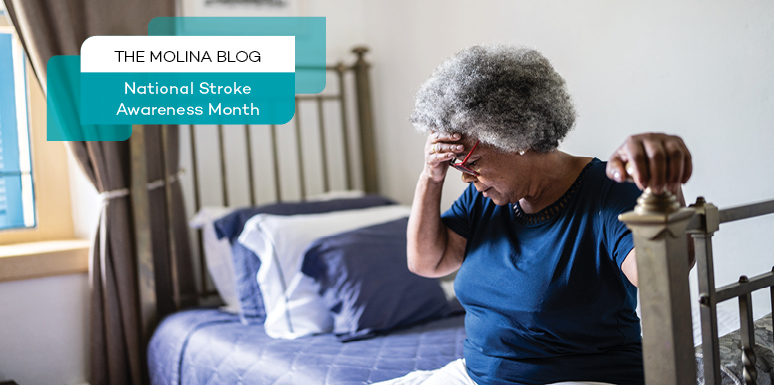May 18, 2023 / Molina Healthcare

Every 3.5 minutes, someone dies of stroke. 1 in 4 adults over the age of 25 will have a stroke within their lifetime.
Stroke risk increases with age, but strokes can and do happen at any time. Younger adults and children can also have a stroke. In fact, about 1 in 7 strokes occur between the ages of 15 to 49. Knowing how to spot a stroke can help you save your life or someone else’s.
A stroke happens when blood flow to the brain stops. There are three main types of strokes:
The brain needs oxygen and nutrients in order to work well. When blood flow to the brain stops, brain cells begin to die. When brain cells die, brain function is lost.
Symptoms
If you or someone you know may be experiencing a stroke, pay close attention to when the symptoms start.
Signs and symptoms of a stroke include:
Act FAST
If you experience any symptoms or signs of a stroke, seek immediate medical attention and call 9-1-1. Think FAST. Use this test to help you recognize the most common signs:
F= Face
Does one side of the face appear to sag or droop? Is the person’s face uneven?
A= Arm weakness
Is one arm weak or numb? Have the person raise both arms. Does one arm drift downward?
S= Speech difficulty
Does the person have slurred speech?
T= Time to call 9-1-1
If the person is experiencing any of the symptoms, call 9-1-1 immediately.
Ways to prevent a stroke:
Keep a healthy weight. To find out if you are within a healthy weight range, visit your doctor. They can help calculate your body mass index (BMI). If you know your height and weight, you can refer to our BMI table. Eating and maintaining a healthy weight helps you live a longer life.
Choose healthy foods and drinks. Eat lots of fruits and vegetables and eat foods high in low saturated fats and trans-fat. Doing so can help lower your cholesterol. You can also lower your high blood pressure by cutting back on salt.
Exercise. Do at least 150 minutes of moderate-intense activity per week.
Some examples include:
Don’t smoke. Smoking tobacco increases your risk of having a stroke. Someone who smokes 20 cigarettes a day is six times more likely to have a stroke compared to a non-smoker. If you smoke, quitting can help reduce your risk.
Avoid drinking alcohol. The more alcohol you consume, the greater risk of a stroke.
Knowing that stroke can affect people around you can be scary. The more knowledge you have on the topic, the better. Don’t let a stroke beat you or a loved one, be prepared to act FAST.
Sources:
https://www.health.harvard.edu/womens-health/8-things-you-can-do-to-prevent-a-stroke
https://www.cdc.gov/stroke/docs/Know_the_Facts_About_Stroke.pdf
https://www.cdc.gov/stroke/prevention.htm
https://www.cdc.gov/stroke/about.htm#:~:text=What%20are%20the%20types%20of,Hemorrhagic%20stroke.
https://www.cdc.gov/stroke/signs_symptoms.htm
https://www.stroke.org/en/about-stroke/stroke-symptoms
https://www.stroke.org/en/about-stroke/types-of-stroke
Category: Seniors / Physical Health